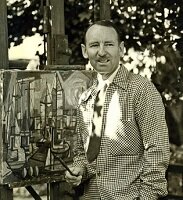An Ocean View
Phil Dike
Scripps College Photo Archive, Ella Strong Denison Library
Phil Dike, N.A. (1906–1990)
Phil Dike was born and raised in Redlands, California. In 1923, he was awarded a scholarship to study at the Chouinard School of Art and later study in New York City with George Bridgman, Frank Vincent DuMond and George Luks. After returning to California in 1929, he began teaching at the Chouinard and was one of the first artists to develop what became known as the California Style of watercolor painting.
In 1935, he became employed full time by the Walt Disney studios. For ten years, he worked as an instructor of drawing and composition, a color coordinator and consultant, and as a story designer on film projects including Snow White and Fantasia. In 1947, he and Rex Brandt formed the highly successful Brandt-Dike Summer School of Painting, which they jointly operated until 1955.
Dike moved to Claremont, California where, from 1950 to 1970, he was an associate professor of art at Scripps College and the Claremont Graduate School. In addition to living in Claremont and painting at Balboa Bay, Dike also built a second home in Cambria on the central California coast. Harbors, driftwood, figures on the beach and dramatic rock formations all became subjects for his many abstract watercolors of this era. Dike is remembered as a thoughtful, caring teacher and is one of the main innovators in the development of the watercolor painting movement in California.
A note from the collector
PD: A Recollection
Phil Dike was a poet, essayist, teacher, and artist. As the artist whose work we celebrate, he formed, then gave content, meaning, and life to the objects—often inanimate— that he had carefully created.
Poet . . . Essayist . . . Teacher . . . Artist. These accomplishments were skills honed, developed, and refined during his years dedicated to chronicling that unique portion of the world known as Southern California.
With pencil and ink, paper and canvas, brushes and pigments, and by calling on life’s lessons, he discovered exciting, novel ways to capture the environment of his land and the spirit and emotions of the people to whom it was entrusted.
By instinct, training, and experiences, he was able to express concern for, but still a joyful acceptance of the life he was given. He achieved a noble ability to communicate to others a sense of life’s continuity and deeper meaning.
With fellow artists Milford Zornes, Tom Craig, Phil Paradise, Millard Sheets, Rex Brandt, Emil Kosa, Jr., and others, Phil created the “California School,” a unique assemblage without a manifesto whose members created works that shared their common love of place.
At every stage of his career, he demonstrated with his work that he lived close to the land, and especially close to the sea. His art reveals a commitment to his belief that life is a journey, a continuing journey in a search of new ways of expressing emotion. The success o success of Phil’s odyssey was possible because of his dedication, talent, and skill. By giving us new ways of interpreting our surroundings, he instills in us unique and abiding reasons for living and believing.
As a collector, I am delighted by and have an unparalleled affection for the art Phil Dike created. His works express a personal view of the world and its essence. He captured his life’s goals, and he did so with distinction.
E. Gene Crain
(Gene Crain passed away on April 5, 2021. You can read his obituary here. It is with both sorrow and gratitude that his words and paintings are shared here now.)
You can listen here to an interview with Gene recorded in 1999 and stored by the Archives of American Art at the Smithsonian Institution.
Scope and Contents
Crain describes the focus of his collection of some 1000 works of art, and how it grew out of his longstanding relationships with artists Millard Sheets, Phil Dike, Rex Brandt, and others. He recalls his relationships with Sheets, Dike, and Brandt at some length, including their feelings for the land as well as their personalities and work. He discusses urban growth, disappearance of the locale and nostalgia in the context of art collecting, and his collection as an important record of a certain time and place. He discusses convenience, climate, and topography as contributing factors to the emergence of the watercolor school as well as other important influences: Pacific rim culture and Far Eastern Art and philosophy; Mexican art and culture; the film industry, especially the Disney Studios; and the federal art projects as a catalyst and support system. Crain discusses the impact of social and economic factors in Southern California during the Depression, contrasting them with harsher conditions in other parts of the country; the development of his eye an aesthetic taste and his patronage of the artists beginning in the early 1960s; the artists' critical standing in the post-World War II period and the "crowding out" of the school by other movements such as Abstract Expressionism and Pop; and the viability of the school in the post-war period, its legacy, and comments on the present market value of the art.

































